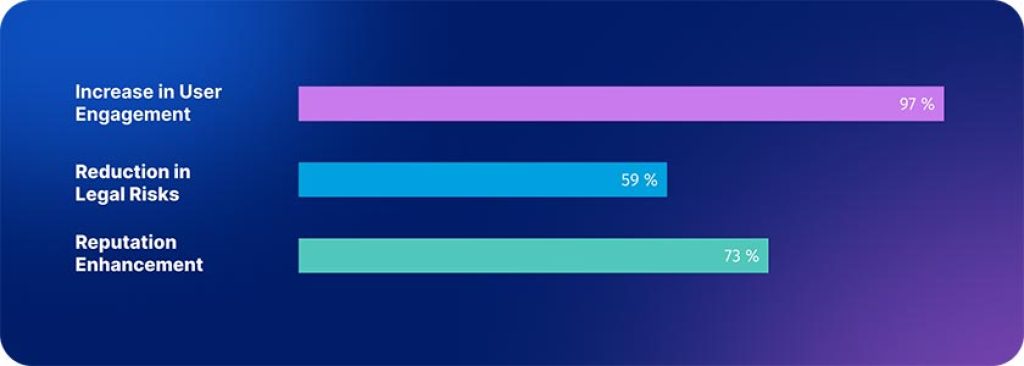ADA Compliant Website Requirements for Businesses of Every Size
Digital Accessibility Conformance for All, from Boutiques to Boardrooms
How does ADA compliance affect your business when you're building or updating a website? The Americans with Disabilities Act (ADA) governs accessibility for all types of services and platforms, both physical and digital. The ADA is a civil rights law that came into being with the intention of preventing discrimination against people with disabilities in all areas of public life.

This covers places of employment, education, all forms of public transportation, and access to public accommodations. With the emergence and expansion of the internet and its place in our lives, ADA requirements have broadened to contain websites, electronic documents, and all forms of digital media, including desktop and mobile applications, computerized interfaces like ATM machines, and more.
In this article, we'll focus on websites. Although as we've just stated, ADA compliance encompasses way more than just websites, it is an excellent place to begin. Why? Let’s talk about that.
The Importance of Inclusive Digital Websites
The increasing use of websites by all businesses has wide-ranging implications for digital accessibility. Digital accessibility refers to how accessible websites and other digital materials are to people with disabilities. Design, back-end and front-end development, and the overall planning of websites and other digital content must take accessibility into account. When people with disabilities such as visual impairments, hearing impairments, mobility impairments, and cognitive impairments are all able to access and navigate all the important information and tasks, a website is considered accessible.
When Is a Website Non-Compliant with ADA Requirements?
Not all websites are created with digital accessibility in mind. This can make it difficult or impossible for people with disabilities to use them. It slows down their navigation, confuses them with poor instructions and descriptions, or even blocks their access to information and services.
What Makes a Website ADA Compliant?
Websites that are ADA compliant are accessible to people with disabilities, including those who are blind, deaf, have low vision, or have mobility impairments. These websites can be navigated and used by people with disabilities without any external assistance other than common assistive technologies such as screen readers, adaptive keyboards, and so forth.
The Small Business Website Boom
The use of websites by small businesses has increased significantly since the early 1990s. In 1993, only about 1% of small businesses had a website. By 2000, that number had increased to 25%. Currently, in 2023, it is estimated that over 90% of small businesses have a website.
There are a few reasons for this increase. First, both the cost and the effort of creating and maintaining a website have decreased significantly. Second, the internet has become an essential part of most of our daily routines. More and more people are using the internet to research products and services, and to make purchases. This means that businesses that don't have a website are missing out on a large potential customer base.
Additionally, a number of government and non-profit organizations now offer financial assistance to small businesses to help them create and maintain websites. This has made it even more affordable for small businesses to have a website.
In short, almost all businesses of every size now have an online presence. It’s doable, they benefit from having a website, and most businesses do spend some time, effort and money on making it happen.
Who Needs ADA Compliant Websites?
You do. Yes, you. Thinking that we don’t know you like that? We don’t, that’s true. But accessible websites help everyone, are more usable for everyone, and take more of the population into account.
Users with Long-Term Disabilities
As we’ve mentioned, it can be hard or impossible for people with disabilities to navigate websites and complete their online journeys, whether the end goal they’re aiming for is a shopping cart click that will ship them a new pair of shoes, a list of local libraries with full wheelchair accessibility, or a phone number to dial to receive critical services. Maybe they want to order a pizza. That shouldn’t be such a challenge.
Older Adults
We all get old, if we’re lucky. Age has a significant impact: the older you get, the more likely you are to become disabled. More than 46% of people 60+ have some form of disability. Upwards of 250 million senior citizens worldwide have disabilities ranging from mild to severe. And, as people live longer, people with existing disabilities who make it to a ripe old age will also contribute to the growing number of older adults with disabilities.
Users with Short-Term Disabilities

- Pregnancy: Temporary pregnancy-related conditions can include anemia, sciatica, gestational diabetes, morning sickness, leg swelling, and depression, among others. Hypertension is the most common medical problem during pregnancy. Blood pressure typically falls in the first half of pregnancy, returning to normal levels by the end of pregnancy. This can lead to dizziness, exhaustion, mood fluctuations, and even blurred vision or sight loss. And that’s ignoring serious maternal complications.
- Temporary Occupation-Related Disability: For students, laborers of all kinds, and people in high-stress situations such as doctors and other health care professionals, temporary disabilities are a fairly regular occurrence.⏲ Average Adults & Children: Things happen. Broken arms, sprained ankles, headaches, an awful case of the flu. Say you have a terrible cold, and you can barely see the screen to do your weekly grocery order. You need digital accessibility. Your 9 year old develops an ear infection, and can’t hear her virtual lesson on the school website? She’ll need accessibility options.
Enterprise-Scale Businesses
Enterprise-scale businesses have a responsibility to make their websites accessible to people with disabilities. They have a large reach and impact. By making their websites accessible, they make a real difference to the community of people with disabilities. And, they cement the company's reputation as an inclusive organization.

Small Businesses
Small, local, and family-owned businesses benefit tremendously from having accessible websites. In today's digital world, a website is essential for businesses of any size. An accessible website can also help small businesses reach a broader audience, including customers with disabilities and the people who care about them. This boosts sales and revenue.
Education At Every Level
Digital accessibility is crucial in education, from kindergarten to university, because today's learning heavily relies on online resources and technologies. Having accessible websites and materials levels the playing field, creating a more equitable learning environment for everyone.
According to the U.S. National Center for Education Statistics, up to 15% of American public school students have a disability, with the most common type of disability being learning disabilities at 32%. The Individuals with Disabilities Education Act (IDEA) mandates that schools offer these students a free and appropriate public education. Accessible educational content provides students with disabilities a fair chance to engage fully in learning. Digital accessibility is critical in offering the same educational opportunities to all students.
Government and Non-Profit Organizations
Government and non-profit organizations must make their websites accessible to serve all of the population equally. They are funded by public money or donations. As part of their responsibility to serve everyone, regardless of abilities, they should provide and promote equal access to information and services.
Am I Obligated to Provide an ADA Compliant Website?
To put it briefly, yes. The ADA does not specifically require that all websites must be ADA compliant. However, the law does require public facilities of all kinds to provide “reasonable accommodations” to people with disabilities. This could include making a website accessible.
The Risks of Non-Compliance
There are several risks associated with businesses whose websites are non-compliant with ADA accessibility laws. These include:
Lawsuits & Financial Hits
People with disabilities who are denied access to a website due to inaccessibility may file a lawsuit against the website owner. These lawsuits can be costly and time-consuming. And, as laws and the enforcement of laws surrounding accessibility are growing, litigation is ballooning too.
Reputational & Brand Damage
A website that is not accessible can damage the reputation of the business or organization that owns it. Customers and clients may be less likely to do business with a company that does not make its website accessible to everyone.
Missed Business Opportunities
A website that is not accessible can prevent people with disabilities from accessing information and services that are available online. This can lead to lost sales and opportunities for businesses and organizations.
Web Accessibility Lawsuits: Can They Happen to Me?
Yes, an accessibility lawsuit can happen to you, even as a small business. The Americans with Disabilities Act (ADA) requires public accommodations, including businesses, to provide accessible websites. This means that your website must be accessible to people with disabilities, such as individuals who are blind, deaf, or have mobility or cognitive impairments.
Despite the misconception that only large enterprises need to meet ADA requirements for web accessibility, the reality is that ADA compliance is mandatory for most businesses, regardless of size, to avoid fines and other penalties. These include labor organizations, educational institutions, government agencies, dining venues, entertainment spots, retail outlets, and small to medium-sized businesses across various sectors.
There are some exceptions, such as entities operating only 20 weeks a year, religious organizations, certain employee-only areas, businesses with fewer than 14 employees, and private clubs.
Even if your business falls into one of the few exempt categories, complying with ADA website requirements is a very positive step. The number of people with disabilities who use the internet is rising. According to Pew Research Center data, a growing 87% of adults with disabilities are internet users. Website accessibility in compliance with ADA requirements contributes to a more equitable and inclusive digital environment for everyone.
Lawsuits Against Large Businesses
There have been several high-profile web accessibility lawsuits in the United States. In one case, a blind woman sued Target for not making its website accessible. The case was settled out of court for $6 million. In another case, a deaf man sued Netflix for not making its streaming service accessible. The case was also settled out of court for an undisclosed amount.
Lawsuits Against Small Businesses
In recent years, there has been a flood of accessibility lawsuits against small businesses of every kind, from restaurants to art galleries. While under the ADA, plaintiffs who bring lawsuits regarding accessibility violations cannot collect damages in direct monetary form, the law does allow court orders that include remediation (fixing) of violations, and that can run into large sums.
It is very difficult or perhaps impossible to know the exact amount of damages that go to the plaintiff in such cases. Plaintiffs can recover legal fees and sometimes secure settlements, and these settlements are usually confidential in most of the United States.
In some states, like California and New York, a plaintiff who wins a case can recover monetary damages on the grounds of disability discrimination. That is in addition to any remediation fees and legal costs.
The bottom line is:
- ADA cases are often settled out of court for an undisclosed amount.
- Demand letters from lawyers regarding ADA violations will often ask for amounts ranging from $1K to $8K for small to medium businesse. Some demands go as high as $50,000. This doesn’t come close to the $6 million Target case award, but then again, your profits as a small business are also not in Target’s range.
- Regardless of how much the plaintiff gets, the business is likely to have to pay a large sum of money, and is also unlikely to care where it goes: legal fees, violations fixed, or to the plaintiff.
How Can I Avoid Losing an Accessibility Non-Compliance Lawsuit?
While some people may feel that the huge wave of ADA website non-compliance lawsuits are unjustified or unfair to their businesses, and in some instances even frivolous or predatory when lawsuits are brought in bulk, accessibility laws exist to make sure that people with disabilities receive fair treatment. The reality is, these lawsuits are happening, and you don’t need to be on the wrong end of one. To avoid being sued, make sure that your website is accessible. There are a number of things you can do to make your website accessible.
Website Accessibility Best Practices for Beginners
- Use clear and concise language
- Use high-contrast colors
- Use large text sizes
- Add alternative text for images
- Make sure your website is compatible with screen readers
Ongoing Website Accessibility Testing and Monitoring
It is important to test your website for accessibility on an ongoing basis. This will help you to identify and fix any accessibility issues that may arise. There are a number of tools, and types of tools, available that can help you to test your website for accessibility.
- Automated tools: These tools automatically scan websites for common accessibility errors.
- Manual tools: These tools allow you, or an expert, to manually test a website for accessibility.
- Hybrid tools: These tools combine automated and manual testing.
Overlays, Plugins and Extensions
While they don’t easily fall into the tool categories above, accessibility overlays, plugins and extensions are a different type of software tool that can be added to a website to improve its accessibility. These can be used to test, scan, or add accessibility functionality to websites, without changing the underlying code. These tools may not fix all your accessibility problems, and you may also have to put in some time making sure your settings are where they should be. But, they are cheaper (and sometimes free), easy to use, and they don’t require major changes to your website. The best choice to solve your accessibility violation issues usually involves some combination of tools and services, with expert oversight advisable.
You can also hire a professional web accessibility expert, or an all-inclusive accessibility company, to help you review your possible accessibility violations, and make your website fully accessible with an accessibility audit. This is likely to cost more, but the results tend to be not just more far-reaching, but they are also respected by governments and legislative authorities.
You’re On Your Way: Complying with ADA Requirements
Many web accessibility lawyers and experts agree that there’s a recurring pattern: the likelihood of a lawsuit against your business website is very low if you’re already in the process of improving your accessibility. And the chances of losing a lawsuit accusing you of website accessibility violations are slim to none if you’re in the midst of remediating any violations. Fixing accessibility issues is considered acting in good faith.
We recommend that you take some of the steps we’ve listed above, such as testing and monitoring, using all the tools available to improve accessibility, and, if you can, reaching out to experts in accessibility who can guide you through the process of adjusting your website’s interface, design, and code so that more people can use it.
By taking steps to make your website accessible, you can protect yourself from being sued and ensure that everyone can enjoy your website.









